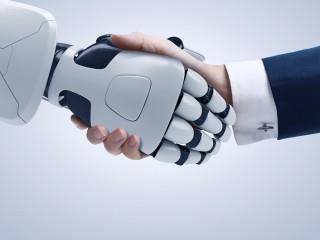A combined future of labour that works
Advances in robotics, artificial intelligence, and machine learning are ushering in a new age of automation, as machines match or outperform human performance in a range of work activities, including ones requiring cognitive capabilities

Technical, economic, and social factors will determine the pace and extent of automation. Continued technical progress, for example in areas such as natural language processing, is a key factor. Beyond technical feasibility, the cost of technology, competition with labor including skills and supply and demand dynamics, performance benefits including and beyond labor cost savings, and social and regulatory acceptance will affect the pace and scope of automation
By
Dimitris Panopoulos*
Advances in robotics, artificial intelligence, and machine learning are ushering in a new age of automation, as machines match or outperform human performance in a range of work activities, including ones requiring cognitive capabilities.
In this article, part of our ongoing research into the future of work, we analyze the automation potential of the global economy, the factors that will determine the pace and extent of workplace adoption, and the economic impact associated with its potential.
Automation of activities can enable businesses to improve performance, by reducing errors and improving quality and speed, and in some cases achieving outcomes that go beyond human capabilities. Automation also contributes to productivity, as it has done historically.
At a time of lacklustre productivity growth, this would give a needed boost to economic growth and prosperity and help offset the impact of a declining share of the working-age population in many countries. Based on our scenario modeling, we estimate automation could raise productivity growth globally by 0.8 to 1.4 percent annually.
About half the activities people are paid almost $15 trillion in wages to do in the global economy have the potential to be automated by adapting currently demonstrated technology, according to our analysis of more than 2,000 work activities across 800 occupations.
While less than 5 percent of all occupations can be automated entirely using demonstrated technologies, about 60 percent of all occupations have at least 30 percent of constituent activities that could be automated. More occupations will change than will be automated away.
Activities most susceptible to automation involve physical activities in highly structured and predictable environments, as well as the collection and processing of data. In the United States, these activities make up 51 percent of activities in the economy accounting for almost $2.7 trillion in wages. They are most prevalent in manufacturing, accommodation and food service, and retail trade, and include some middle-skill jobs.
Technical, economic, and social factors will determine the pace and extent of automation. Continued technical progress, for example in areas such as natural language processing, is a key factor. Beyond technical feasibility, the cost of technology, competition with labor including skills and supply and demand dynamics, performance benefits including and beyond labor cost savings, and social and regulatory acceptance will affect the pace and scope of automation.
The main scenario suggests that half of today’s work activities could be automated by 2055, but this could happen up to 20 years earlier or later depending on the various factors, in addition to other wider economic conditions. People will need to continue working alongside machines to produce the growth in per capita GDP to which countries around the world aspire. Our productivity estimates assume that people displaced by automation will find other employment.
The anticipated shift in the activities in the labor force is of a similar order of magnitude as the long-term shift away from agriculture and decreases in manufacturing share of employment in the United States, both of which were accompanied by the creation of new types of work not foreseen at the time.
For business, the performance benefits of automation are relatively clear, but the issues are more complicated for policy-makers. They should embrace the opportunity for their economies to benefit from the productivity growth potential and put in place policies to encourage investment and market incentives to encourage continued progress and innovation.
At the same time, they must evolve and innovate policies that help workers and institutions adapt to the impact on employment. This will likely include rethinking education and training, income support and safety nets, as well as transition support for those dislocated.
Individuals in the workplace will need to engage more comprehensively with machines as part of their everyday activities, and acquire new skills that will be in demand in the new automation age.
The crucial key findings of the extended two -year period of research of the Mc Kinsey Global Institute (Jan. 2017), when compared by the writer, to three global-range similar technical researches, published in 2017 and 2018 are the following:
•
We are living in a new automation age in which robots and computers can not only perform a range of routine physical work activities better and more cheaply than humans, but are also increasingly capable of accomplishing activities that include cognitive capabilities. These include making tacit judgments, sensing emotion, or even driving—activities that used to be considered too difficult to automate successfully .
•
The automation of activities can enable productivity growth and other benefits at both the level of individual process and businesses, as well as at the level of entire economies, where productivity acceleration is sorely needed, especially as the share of the working age population declines in many countries.
At a microeconomic level, businesses everywhere will have an opportunity to capture benefits and achieve competitive advantage from automation technologies, not just from labor cost reductions, but also from performance benefits such as increased throughput, higher quality, and decreased downtime.
At a macroeconomic level, based on a similar scenario modelling conclusion of the existing researches, the writer of the article estimates automation could raise productivity growth on a global basis by as much as 0.8 to 1.4 percent annually(medium perspective scenario/Multiplier slightly growing to 1,6%).
•
The approach towards analyzing the potential impact of automation is through a focus on individual activities rather than entire occupations. Given currently demonstrated technologies, very few occupations—less than 5 percent—are candidates for full automation today, meaning that every activity constituting these occupations is automated.
However, almost every occupation has partial automation potential, as a significant percentage of its activities could be automated. McKinsey Global Institute estimates that about half of all the activities people are paid to do in the world’s workforce could potentially be automated by adapting currently demonstrated technologies.
*Executive of Labour Market Needs’ Diagnosis Mechanism, Ministry of Labour, Social Security and Social Solidarity in Greece



 By: N. Peter Kramer
By: N. Peter Kramer
